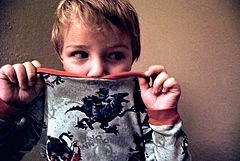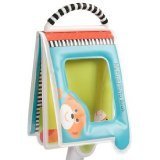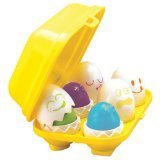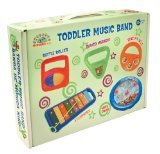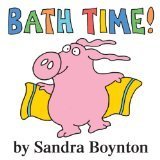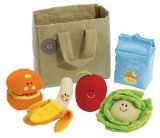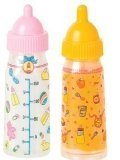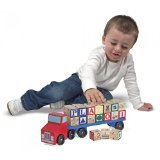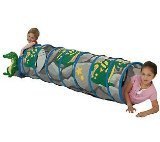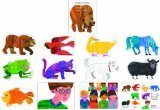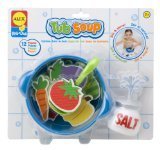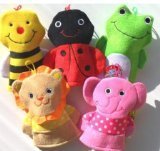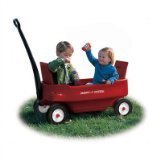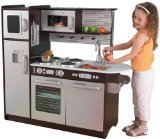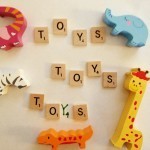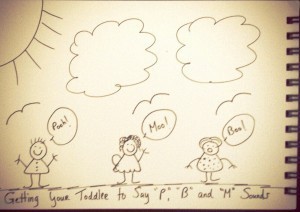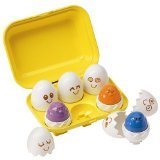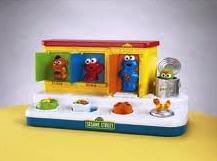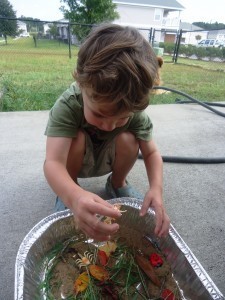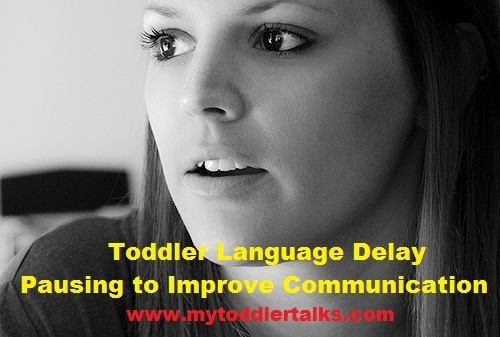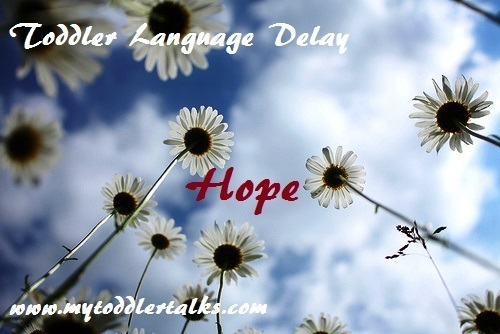Kimberly Scanlon's Blog, page 5
February 21, 2014
8 Ways to Get Your Toddler to Communicate
Part II – 8 Ways to Get Your Toddler to Communicate
Photo Credit: theothernate
Last month, I wrote a post on Why Does My Toddler Pull and Point but Not Talk? If you missed it, I recommend reading that post first. I was inspired to write this two post sequence in response to a question from a My Toddler Talks reader. To recap, here’s the question:
“Our toddler has gotten into this habit of pulling us to, pointing to or handing us the things she wants without actually saying or making any sound when she wants it. If we don’t give her what she wants she start screaming and crying (literally). I don’t want to reward the screaming behavior but I also want to encourage her to speak, so I’m a little stuck there.”
Since I’ve introduced some of the reasons why a toddler pulls or points but not talk, let’s talk about how we can encourage this toddler to more effectively communicate her wants and needs.
Notice – I’ve written EFFECTIVELY COMMUNICATE? I didn’t write talk. Any guesses on where I’m going with this?
It means I want the child to gesture, sign or try to say a sound or word OR, I want her to try to do these things in conjunction with pointing or pulling you.
Here’s what I would recommend -
1. Start with what your toddler can do.
Are there any sounds, gestures or signs that she can do? If so, start there and try to increase the frequency of those sounds, gestures, and signs. You can do this by imitating her sounds, gestures, or signs. Then, use those sounds, gestures, and signs and apply them in different contexts. For instance, if your child, let’s call her Annie, can wag her finger for the finger play – “5 Little Monkeys”, but she doesn’t use it in any other instances, it’s your job to have her wag her finger during other appropriate times. For instance, she could wag her finger at the family dog when he chews her toy (Oh wait, does that only happen in my household?)
Think – What gesture(s) do/does your child and how can you build on it? Start there.
2. Get her making some noise!
Was Annie a loud baby? Did she babble or engage in any vocal play? These are questions I often ask my parents. Many children who are late to talk are described as being quiet babies who may not have babbled or played with their voices. If your toddler is still quiet and only communicates via pulling, pointing, screaming or crying it’s imperative that we get them making some noise. If this is the case, I would also highly recommend seeking an evaluation by certified and licensed speech language pathologist. When I work with children who are not yet talking I try to see if they’ll imitate some sounds. I pretend to have a cold and cough and sneeze and make it into a game. I’ll say, “Oh I need a tissue, I’m going to….achoo!” or “Ooh, I have a tickle in my throat…cough, cough.” Toddlers usually think this is hilarious and often want to act out this play routine too. I also try to encourage animal sounds like a dog growling , barking or panting, a cow mooing, or a cat meowing. Really anything goes! The point is you want to see if your child can have fun with his or her voice and volitionally make any sounds. When this occurs, your child can then make these noises to initiate an exchange. For instance, my daughter things it’s funny to squeeze her nose, point to you and say “stinky” (grandma taught her that one). When she does this it’s her way of trying to get you to laugh because she thinks she so funny. Most toddlers want to laugh and want to make YOU laugh.
Think – What are some funny sounds I can make that will promote imitation and laughter?
3. When Annie does attempt a sound or gesture – react to it immediately.
When a child utters a new sound or word it catches us off guard. This causes a flurry of internal thoughts that looks something like this:
First possible thought: “Wait a second, did she just say cookie? She was pointing to the cookie jar and it sounded like cookie. Did she really say cookie? Honey, I think Annie just said cookie.” While we’re pondering this, even if it’s just for a few seconds, we haven’t yet given the cookie to the child. We’re just standing there; probably secretly hoping that the child will say it again crystal clear.
Second possible thought: “Well, if she did say cookie, I’m going to see if she can say it again. Sweetie, what did you just say? Can you say that again for mommy.” We want the child to say it again to justify to ourselves that he or she just said that word and can say it again. When a child can repeat the word (especially on command) we get a warm fuzzy feeling. We like warm fuzzy feelings.
Third possible thought: “Hmmm….it sounded a little like cookie, but not really. Let’s see if she can say it any better. Sweetie, look at mommy’s mouth, say “c—c—cookie”.
These flurries of thoughts are natural and there’s no stopping them. However, it doesn’t mean that we have to delay responding to the child’s verbal request. If I’m losing any of you here, please try to stay with me. My point is, if your child just attempted a new word, gesture or sound, enjoy the moment (give your child a big smile), repeat it (“Cookie”) and then give him the desired item or somehow acknowledge his attempt (“Here’s the cookie, sweetie”.).Then, while the child is enjoying the cookie, talk about the cookie. By responding to your child in a natural and relaxed way, your child will be likely to repeat the word, sound, or gesture because he sees that communicating is a nice experience. (Please note – these examples and advice pertain to when the child begins to communicate. This advice does not necessarily pertain to articulation delays or disorders or oral motor disorders. Skillful repetition is very important when it comes to improving a child’s intelligibility. That’s a topic for another post.)
4. Encourage face to face interaction
 Photo Credit: Defence Images
Photo Credit: Defence Images
Get down at your toddler’s eye level. When you’re little, it’s hard to have a conversation with someone who’s towering over you and causing you to strain your neck. This may require you to squat down, sit on the floor, kneel, etc when talking to your toddler. When you’re eye level you have a better chance of picking up on subtle cues or facial expressions. Seems like common sense, right? It is!! But, honestly think about it. In those moments when you’re in the kitchen and your little one is frantically pointing and crying because he wants to eat something, are you kneeling down and communicating with him at eye level? Or, are you standing, scratching your head, thinking, when is bedtime? See the picture above? The child still has to look up a little, so I would even get down lower than that!
Hold desired objects close to your face. I like to place the desired object by my cheek area, somewhere between my mouth and eyes. This way the child has the option of looking at my mouth or eyes. With toddlers, I never force eye contact. If the child looks at your mouth, he may try to imitate your mouth’s movements (great for targeting those visual sounds like, “ooo:, “eee”, “mmmm”, “pa” and “ba”. If he looks at your eyes, that’s wonderful too.
5. Make her work for it….for just a bit.
Don’t withhold desired items until she attempts to imitate you. That is just plain mean. Say the target sound, word, sign, or gesture a few times (I recommend 3 times) and then rightfully hand over the desired item. For example, Annie has pulled you into the kitchen and is pointing to Annie’s Bunny Graham Crackers (my daughter loves these). Don’t just instantly hand them to her. MAKE IT INTO A GAME. Act like saying the sound, doing the gesture, or performing the bunny dance is so incredibly fun, that she’ll just have to do it! Plus, she’ll be motivated to do it because she wants a bunny cracker! Encouragement is necessary because if we overly anticipate what the child wants and always readily give in to what they want because WE KNOW WHAT THEY WANT, they will never make the connection that they have to do something to get it!!
6. Teach them a sign, gesture, gross body movement or just dance.
Back to the previous example. If Annie wants the bunny crackers, you can jump around like a bunny while saying bunny and or, you can sign for bunny while saying bunny. Here’s a youtube video that teaches the sign bunny:
Children who imitate gross body movements (jumping around like a bunny) or sign have a better chance of acquiring speech. Sara Bingham, the founder of WeeHands, a sign language program, has a phenomenal book, The Baby Signing Book: Includes 450 ASL Signs for Babies and Toddlers
 . Bingham’s book provides a wealth of information that explicitly teaches readers how to sign with their babies or toddlers and why it’s recommended. In one research study, she cites: “the speech areas of the brain develop later and more slowly than related motor areas of the brain, while motor control of the hands develop earlier than motor control needed for speech” (29). I also found Sara’s detailed, research driven explanation of how sign language develops very valuable. Just like spoken language has developmental phases so does sign language. Introduce signs or gestures that are going to be the most useful to help her communicate. And, make the interaction fun! You can do this by signing while reciting a favorite nursery rhyme or while reading his or her favorite board book!
. Bingham’s book provides a wealth of information that explicitly teaches readers how to sign with their babies or toddlers and why it’s recommended. In one research study, she cites: “the speech areas of the brain develop later and more slowly than related motor areas of the brain, while motor control of the hands develop earlier than motor control needed for speech” (29). I also found Sara’s detailed, research driven explanation of how sign language develops very valuable. Just like spoken language has developmental phases so does sign language. Introduce signs or gestures that are going to be the most useful to help her communicate. And, make the interaction fun! You can do this by signing while reciting a favorite nursery rhyme or while reading his or her favorite board book!7. Give Choices
Giving choices not only promotes language development, but also increases problem solving, independence, confidence and compliance. If you’ve read Love and Logic Magic for Early Childhood: Practical Parenting From Birth to Six Years
 you know what I’m talking about. I’ve already written an entire post about how to give choices and have multiple examples throughout My Toddler Talks. So, next time your child is pointing or pulling you to the book shelf, present two options and have her choose by encouraging a sign, sound, word, gesture, facial expression or even a dance!
you know what I’m talking about. I’ve already written an entire post about how to give choices and have multiple examples throughout My Toddler Talks. So, next time your child is pointing or pulling you to the book shelf, present two options and have her choose by encouraging a sign, sound, word, gesture, facial expression or even a dance!8. Does my child understand what I’m saying?
 Photo Credit: SAN_DRINO
Photo Credit: SAN_DRINO
Toddlers understand words before they can say them. This concept shouldn’t be too shocking because this learning phenomenon is the same throughout our lifetime. We understand far more words we hear and read versus those we use during conversational speech or in our writing. In the book, Vocabulary at the Core: Teaching the Common Core Standards
 (a must read for any professional who works on vocabulary development), authors Amy Benjamin and John Crow state: “Knowing a word is a matter of degrees of depth: knowing the gist of a word is, quite often, all you need when you hear or read a word. As you become better acquainted with a word, you begin to know its nuances, connotations, etc. In other words, you must be in control of a lot of information about a word before you are able to use it properly.” They go on to state that, “acquiring productive control over words is normally a gradual process. Bits and pieces are added to your body of knowledge about a new word as you are exposed to it in a variety of contexts and situations.” When I read this, I was emphatically shaking my head, yes, yes, yes! This information also applies to toddlers! Therefore, it’s going to be easier to expect a toddler to start saying words that he understands! So, when you are modeling words and making her work of it…for just a bit, use words that you know or think she understands. For instance, she seems to understand the word bib because she runs to the kitchen and gets it. She seems to understand shoe because she looks down and touches them when I say the word. She seems to understand sit because she’ll sit down when asked. If this is the case, then bib, shoe, and sit could be words that you could try to make her work for it…just a bit.
(a must read for any professional who works on vocabulary development), authors Amy Benjamin and John Crow state: “Knowing a word is a matter of degrees of depth: knowing the gist of a word is, quite often, all you need when you hear or read a word. As you become better acquainted with a word, you begin to know its nuances, connotations, etc. In other words, you must be in control of a lot of information about a word before you are able to use it properly.” They go on to state that, “acquiring productive control over words is normally a gradual process. Bits and pieces are added to your body of knowledge about a new word as you are exposed to it in a variety of contexts and situations.” When I read this, I was emphatically shaking my head, yes, yes, yes! This information also applies to toddlers! Therefore, it’s going to be easier to expect a toddler to start saying words that he understands! So, when you are modeling words and making her work of it…for just a bit, use words that you know or think she understands. For instance, she seems to understand the word bib because she runs to the kitchen and gets it. She seems to understand shoe because she looks down and touches them when I say the word. She seems to understand sit because she’ll sit down when asked. If this is the case, then bib, shoe, and sit could be words that you could try to make her work for it…just a bit.If you’re in need of some additional free and helpful resources, please subscribe to my newsletter. I share information and handouts exclusively with my newsletter subscribers.
If you have enjoyed reading My Toddler talks, please help spread the word. Tell your friends, write an honest review on Amazon, click the social media buttons or personally give me your feedback. I love hearing from my readers and value your input. YOU are the reason why I devote so much time to perfecting my craft. Thank you.
If you’re in need of some more tips, please see the following posts:
How Pausing Improves Communication
How to Effectively Use Self-Talk and Parallel-Talk
Thanks for reading!
The post 8 Ways to Get Your Toddler to Communicate appeared first on My Toddler Talks.
January 28, 2014
Why Does My Toddler Pull and Point but Not Talk?
Why Does My Toddler Pull and Point but Not Talk?
Every so often a My Toddler Talks Reader emails me with a question. I find that if one person takes the initiative to write me, it probably means that there are many others who have the same concerns. Here’s the question that motivated me to write this 2 post series.
“Our toddler has gotten into this habit of pulling us to, pointing to or handing us the things she wants without actually saying or making any sound when she wants it. If we don’t give her what she wants she start screaming and crying (literally). I don’t want to reward the screaming behavior but I also want to encourage her to speak, so I’m a little stuck there.”
Photo Credit: deltaMike
Since the answer to this question is quite involved, I’m going to divide my response into 2 posts. For this post, I will address (or, at least try to) why a toddler would pull, point or hand over items instead of trying to talk. The next post I will share tips.
Here we go!
My toddler pulls, points, or hands over items because…
It’s been somewhat effective in the past.
A child may use more basic modes of communication because she has had success with them in the past. For instance, she pulls you over to the refrigerator because you assume she wants to eat or drink, so you give her a favorite snack. She points to the banana because you assume she’s hungry. She hands you a wind-up toy because you assume she wants you to wind it up. Notice how I’m using the word assume? When a child doesn’t yet have the words or more sophisticated signs or gestures to effectively communicate, we often have to assume what a child wants or needs. When we make the wrong assumption or honestly have no idea what she wants or needs, what happens?
Photo Credit: peter.clark
Does not yet understand that certain gestures (e.g. pointing), signs, and words have meaning.
Before children start saying their first words, they communicate by using certain gestures, sounds, or body movements (e.g. pulling you to something, raising hands to be picked up, etc.) these are known as pre-linguistic or pre-symbolic gestures. In typical development, these gestures progress to symbolic gestures, like pointing and signs and finally verbal language. When a child understands that their actions, sounds or words are meaningful and represent something (e.g. tapping finger tips means more), they are paving the way for more sophisticated language development. I should note that many children with autism tend to overly rely on pre-symbolic gestures such as, pulling or leading parents to what they want.
Photo Credit: Kevin N. Murphy
Has difficulty coordinating oral, fine, or gross movements needed for speech, signs or gestures.
Some children with certain disorders or syndromes like childhood apraxia of speech, cerebral palsy, autism, as well as those with vision and auditory impairments and learning disabilities may have difficulty coordinating, controlling, and executing the movements required for speech and signing. Accepting approximations of a word (e.g. ba for ball) or sign (e.g. taps fists together for more instead of finger tips) should be encouraged and accepted. Alternative means of communication can also be introduced to establish functional communication. If you have concerns, please notify your pediatrician and consult with a licensed and certified speech language pathologist.
Photo Credit: Kevin N. Murphy
They don’t know what else to do.
If a child hasn’t been introduced to signs or certain gestures or their communicative partners are not modeling and repeating new words, they won’t know what else to do! We, the parents, the therapists, the educators, have to provide the signs, sounds, and words multiple times in a loving and reassuring manner. Humans are hard-wired for communication. Regardless of the diagnosis or severity, we all want to communicate. If your child is not yet communicating or struggling to, it’s not because he or she is stubborn. It’s because they need a little time and some support.
Photo Credit: TomConger
I hope you have found this post helpful. If you can think of any other reasons why a child may struggle to communicate, please comment below.
Stay tuned! Early next month, I’ll be sharing my follow-up post: 7 Ways to Get Your Toddler to Communicate.
Some other posts you may like:
5 Ways to Stay Hopeful When You Want to See Change Now
When Do Toddlers Start Talking?
How to Get the Most from My Toddler Talks
The post Why Does My Toddler Pull and Point but Not Talk? appeared first on My Toddler Talks.
January 7, 2014
Speech Therapy for Toddlers: Don’t Be Annoying
Speech Therapy for Toddlers: Don’t Be Annoying
Ever have one of those moments when you hear or see yourself on a video and think, “Is that really me? Am I really doing that? I had one of those aha moments last month when I was watching a video of my daughter saying a new word.
Photo Credit: Visentico / Sento
Before you click on the video, read this background information:
In this video, my daughter was 16.5 months old. It was post bath time and we were getting ready for bed. I worked a long day and drove 45 minutes (in NJ traffic) to my parent’s house where my mom babysits when I work (For any of my FB fans or long term followers, K used to be in daycare but I recently took her out due to health reasons). I arrived home in a stellar mood. I had fantastic sessions. My clients were making nice progress and their parents were happy. When my clients are happy, I’m happy. So, when I saw my little girl after being away for a few hours, I was very excited. I was even more thrilled when I learned that she picked up a new word – ICE. I decided to video record her because my husband was traveling and I was hoping to share it with him. As you’ll soon see, K is feisty, smart, mischievous, cute and, has A LOT of hair!
Now that you have the background information, ponder the following questions when viewing this video:
When does she say ice?
Why do you think she said ice?
Why do you think she wouldn’t say it again?
What am I doing wrong?
Have you been guilty of acting like me?
Got it?
Now, click on the video:
So…what are you thinking? Feel free to comment below. I love hearing from “the other side”!
Here are some answers to my questions:
When does she say ice?
Answer: In the first clip of the video, she easily and effortlessly says “ice” in response to my direct yet pressure-free question – “Do you want some ice?”
Why do you think she said ice?
Answer: Of course, I don’t know for certain, but I believe she said ice, because I wasn’t putting direct pressure on her to “perform” or imitate me. Additionally, the target word “ice” was included at the end of my question (“Do you want some ice?”) so she had immediately heard it and it was fresh in her mind.
Why do you think she wouldn’t say it again?
Answer: Because I was annoying! First off, she already said “ice” so in her little mind and pragmatically speaking, why should she have to say it again? Secondly, not only was I staring at her and demanding that she say ice, but she had an audience to perform in front of – my own mother and my uncle. It makes sense that she clammed up and didn’t or couldn’t say it again.
What am I doing wrong?
Answer: Hint: If you have a print copy of My Toddler Talks – turn to page 15. What is the first “R” in “RAISES”? I violated one of my own tips! What’s funny is that, I would never put so much pressure on one of my little clients. In fact, I often coach my parents to NOT act like this. So, why then was I so demanding and persistent?
Because I wasn’t acting as a speech therapist.
I was a mom.
An overly-excited mom who wanted to hear her daughter imitate a word as validation that her daughter – had it. I wanted K’s volitional imitation of “ice” as reassurance that it was acquired and that she could do it again on command.
Have you been guilty of acting like me?
That’s for you to reflect on.
By seeing myself in action, as a mom NOT a speech therapist, I learned a great deal. I learned that sometimes it’s hard to remember all the right things to do in the moment. More importantly, I learned that the next time my K says a new word, I’m going to enjoy the moment. Savor it. I’m not going to demand and pressure that she say it again and again. Simply, I’m not going to annoy her too much.
P.S.
Yes, we were all pretty impressed with her coming out, quite assertively, with “I said that!” None of us were expecting it – which can be the topic of entirely different post – “Sometimes Language Happens When You Least Expect It”.
The post Speech Therapy for Toddlers: Don’t Be Annoying appeared first on My Toddler Talks.
December 9, 2013
Speech Therapy Toys for Toddlers
Speech Therapy Toys for Toddlers
Every year I write a post with some of my favorite toys for toddlers and preschoolers (the preschooler post will be up at www.scanlonspeech.com in the next few days). Since I treat many toddlers with language delays, I have a pretty good knack for selecting toys and using them to promote language development. Now that I have a toddler myself, I created this list with my little girl in mind. I have included some of her favorites, some that I intend to buy, and some that I have effectively used with other toddlers during my speech therapy sessions.
First I’ll start with -
7 of K’s Favorite Toys (that she’s enjoyed from 12 months to present)
Melissa & Doug Pretty Purse Fill and Spill

Fantastic toy for the young toddler who still likes to literally fill and spill items. By playing with this toy so many times, K can quickly identify purse, keys, phone and money. She can also distinguish between mommy’s purse or mommy’s keys versus K’s purse or K’s keys. Remember, receptive language typically comes before expressive language. So, even if your child is not talking, you want to make sure they understand what you are saying.
Fill this photo book with pictures of your child’s family and friends and it will provide a fantastic opportunity for them to identify faces and say their names. This is especially helpful if you want to ensure that relatives who live far away are remembered.
TOMY Little Chirpers Sorting Eggs Learning Toy

These eggs are adorable but consider yourself warned – depending on the age and abilities of your child, you may spend a good amount of time picking them up and finding them under the couch or hidden in cabinets. Fun, right! But, it gets them moving, thinking, and talking. Feel free to check out my other post on how I use these sorting eggs to elicit language.
Fisher-Price Brilliant Basics Little Super Star Classical Stacker

Last Christmas, my little K received this stacker from her grandparents. Typically, I’m not into toys that light up and make too many sounds. BUT, what I really like about this toy is that in addition to being a good stacking toy, my K has discovered that she can make the toy light up and make music whenever she presses its side button or puts on and takes off the star rings. And, that’s great for developing the skill of cause and effect. Also, the light and sounds are quick and not over-stimulating.
Super cute book. K will now say more and sign for cheerios. She earnestly pushes each one into its respective places. Good not only for language and cognition, but also for developing fine motor skills and pointing with the index finger.
Hohner Kids Toddler Music Band

Great set of musical toys for play dates!
Sandra Boynton’s Bath Time! Book
 This book is adorable. K likes to point to the various “toys that like to float”.
This book is adorable. K likes to point to the various “toys that like to float”.
By Christmas, K will almost be 17 months old (time is flying!). I’m buying toys that she can currently enjoy but also grow into.
K’s Christmas Toy List
Earlyears Lil Shopper Play Set

BABYDOLL Magic DOLL Bottles SET Of Two MILK & Juice girls toy

As a little girl, I loved playing with bottles like these and was fascinated by seeing the liquids appear and then disappear. Since K gets a kick out of a tucking her dolls to sleep, I think she will take to feeding them with these cool bottles. Many possibilities for language expansion.
My mom already purchased this item from Khol’s (get that Khol’s cash and use those coupons!). I really like this toy because it’s so versatile. K can take the blocks off and then put them back on, eventually use the blocks for stacking, knocking down, and building, as well as pushing around the truck.
Pacific Play Tents Dragon 6′ Tunnel

K loves climbing and moving around. Her cousin had this tunnel and loved it! This should be great fun during the cold winter months. Have plans to target prepositions and verbs!
Brown Bear, Brown Bear, What Do You See? Bulletin Board Set

This is an item I already bought to use with some of my clients. The wall decals are much bigger than I thought they would be. Since she likes the book, Brown Bear Brown Bear, I figured displaying these decals on her wall would be a nice opportunity to give more exposure to targeting animals and colors.
Hohner Kids HO378 Puppy Slide Flute/Whistle

Music making time!
Chugga chugga choo choo!
ALEX® Toys – Bathtime Fun Tub Soup 801W

I’m really excited to use this one! Wonderful way to name and label different fruits and veggies in a fun and low pressure way. K is not the best eater secondary to severe reflux, but she’s getting much better.
I’m picturing myself already saying, “K, would you like the frog or the ladybug?”
Toys that will have to wait until her second birthday:
Sensory Stepping Stone Balance Pods Set of 6

While these are a little pricey, they’re worth it. A former client of mine had these and they provided endless opportunities for various types of movement based play.
Okay, I may purchase this before her 2nd birthday just because K had a blast playing on her cousin’s slide. Perfect for targeting “up”, “down”, “my turn”, “your turn” and of course…”weeee”.
Radio Flyer Pathfinder Wagon®, Red

Oh geeze, this may be another item I buy before she turns 2 too! I can’t help it. Since she gets an absolute kick out of carting her baby dolls around in her shopping cart, I think she’ll love this wagon. Already envisioning us outside on a nice spring day.
KidKraft Uptown Espresso Kitchen

This kitchen is 10 times nicer than our galley kitchen with linoleum… 
JC Toys La Newborn (Expressions May Vary)

This is an anatomically correct doll…thinking it may be nice to introduce when she starts potty training.
So, what toys are on your list? Have any recommendations? Please feel free to share in the comments.
In need of more? Check out the bottom links:
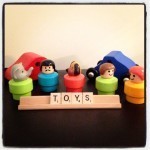
Speech Therapy Toys for Toddlers and Preschoolers
The post Speech Therapy Toys for Toddlers appeared first on My Toddler Talks.
December 2, 2013
Speech Therapy for Toddlers: 12 Helpful Posts You Can’t Miss!
Speech Therapy for Toddlers: 12 Helpful Posts You Can’t Miss!
Before I created the My Toddler Talks website, I blogged about toddlers over at my other website Scanlon Speech Therapy. I started blogging back in early 2011. I still blog at Scanlon Speech but mostly on speech, language, and literacy topics related to preschool and early school aged children. Over there, I also have guest posts and interviews with well-respected speech language pathologists and/or other childhood experts. If these topics interest you, feel free to bounce over there. But, since I still have some fantastic blog posts over there all about toddlers, I decided to compile this post to highlight some of my favorite toddler related blog posts ranging from books, techniques, activities and more.
Hope you enjoy.
How to Use Books to Improve Your Toddler’s Communication Skills
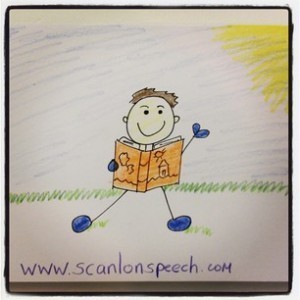
How to Read Books to Toddlers
How to Read Brown Bear Brown Bear What Do You See to Get Your Toddler Talking
How to Read Brown Bear Brown Bear to Get Your Toddler Talking
Snuggle Puppy A Little Love Song for Your Toddler
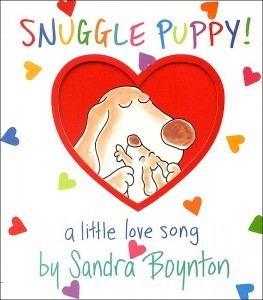
Using Snuggle Puppy to Increase Your Toddler’s Speech and Language
Chitchatting and Reading with Your Toddler
Types of Books to Improve Your Toddler’s Language
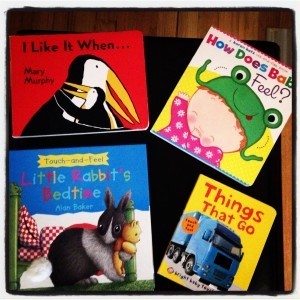
Types of Books to Improve Your Toddler’s Language
Oral Motor Development and Pacificers – When and How to Break the Habit. An Interview with an Expert
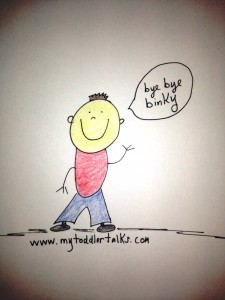
Oral Motor Development and Pacifiers. An Interview with An Expert
Getting Your Toddler to Say the P, B, and M Sounds
Getting Your Toddler to Say the P, B, and M Sounds
How Arts and Crafts Help Develop Language in Young Children
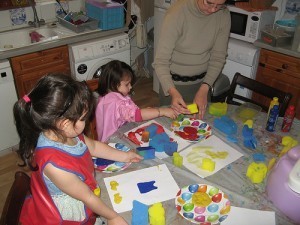
How Arts and Crafts Help Develop Language in Young Children
An Arts and Crafts Activity to Improve Speech and Language in Toddlers
An Arts and Crafts Activity for Toddler Language Development
Incidental Learning and Speech Therapy
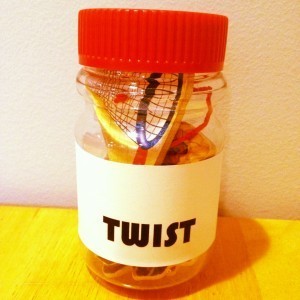
Incidental Learning and Speech Therapy
Expansions and Extensions to Improve Your Child’s Language

Expansions and Extensions to Improve Toddler’s Language
My Favorite Apps for Toddlers and Preschoolers
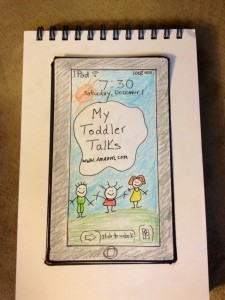
My Favorite Apps for Toddlers and Preschoolers
The post Speech Therapy for Toddlers: 12 Helpful Posts You Can’t Miss! appeared first on My Toddler Talks.
November 4, 2013
Early Intervention for Toddlers: How to Include Siblings
Early Intervention for Toddlers: How to Include Siblings
Speech therapy with toddlers should be fun and engaging. Since it’s so enjoyable, sometimes this happens:
“Mommy, mommy, I wanna play. What about me? It’s my turn now!”
If you provide services to families with more than one child, I’m sure these comments sound pretty familiar. I’ve treated and currently work with several families who have multiple young children. When ALL children are present, things get pretty interesting.
Since we ideally want to focus in on the child with the language delay, parents usually try their best to eliminate distractions and interruptions from other siblings. While some older siblings may prefer to sit back, relax and enjoy the show, more often than not, the sibling of the child receiving the services feels left out. If the sibling insists on joining in, it may be wise to strategically include him or her into part of the session.
Why include the other child?
Besides trying to make everything copasetic, I believe it’s important to include the sibling for the following 2 reasons:
When a child has a language delay, it’s quite common for the other sibling(s) to speak for the child with the delay. I’ve witnessed this dozens of times. When this occurs, it impedes the language development of the child with the delay because he or she is missing out on excellent opportunities to communicate.
Secondly, in most cases the child you’re “treating” is used to playing with his sibling(s) at home. When families make time to play, they usually ALL play together. If one child dominates the play, we can show parents how to effectively include a sibling into the session or play routine so that each child is equally participating.
Two Tips for Speech Language Pathologists
Develop a good rapport. First and foremost, establish a good rapport with the child you are treating. I strongly believe that for therapy to be effective, the toddler has to enjoy your company and be having a pleasant experience (Yes, I know, I mentioned this before). Before, including his or her sibling, take time to create a mutually respectable relationship with one another.
Set limits, have “talking” rules, or assign roles. Once you have a good rapport established and you understand what techniques work for the child, include the sibling. Make sure he or she knows what is expected of him or her. Tell the sibling, what will happen and how he or she can participate so that everyone has a turn. Modify how you set limits based on the child. Johnny (the child with the language delay) will push the car down the ramp and try to say “wee” and Cindy will select the next car for Johnny to push. All children regardless of age or ability level like to have boundaries because it helps them regulate their thoughts and emotions. Establish the rules or roles early on and coach parents to carry through with them at home. For instance, if the sibling is very chatty and tries to speak for Johnny we have to clearly explain to his sister, Cindy, to be quiet when it’s Johnny’s turn because that helps him think and gives him a chance to talk.
Two Tips for Parents
Have a heart-to-heart. Before the speech therapy session or play routine begins, talk to the sibling who is not receiving the therapy and explain why it’s really important to give Johnny a chance to think and talk. If the sibling is a little older and attends school, explain how this is similar to school (“You go to school to learn colors, shapes, and numbers. Jeffrey is learning how to talk. This is his school time. It’s important that we let him learn without interruptions”).
Play a listening or watching game. Assign a listening or watching role to the sibling. When the sibling hears or sees something that you have assigned, have them do something. For instance, you could tell Cindy, “Each time Johnny says the word help , draw a happy face with your brand new markers” or “Whenever you see Max sign for more, drop a penny into your piggy bank”. These suggestions are just ideas. Choose something that will be rewarding and or value to the sibling, but not distracting to the child receiving the treatment.
If you are a parent or therapist and have additional tips to share, please comment below.
If you are in need of some additional free and helpful resources, please subscribe to my newsletter – I share more information exclusively with my newsletter subscribers.
If you have enjoyed reading My Toddler Talks, please help spread the word about my book. Please tell your friends, write an honest review on Amazon, click the Facebook like button on landing page, or personally give me your feedback. I love hearing from my readers and value their input. You are the reason why I devote so much time to perfecting my craft 
The post Early Intervention for Toddlers: How to Include Siblings appeared first on My Toddler Talks.
September 30, 2013
Language Development for Toddlers: Set it Up
Language Development for Toddlers: Set it up
Setting it up means you have designed an environment or situation that supports or fosters communication. Doing so motivates your child to talk.
Our goal is to: Promote child initiated communication.
This strategy is used by many speech language pathologists because it’s very effective. Many of us are so good at it that it doesn’t even seem intentional to those observing. But, believe me folks, it’s very intentional.
As parents, we take pride in knowing our children so well that we can predict and anticipate their every whim. Knowing our child’s needs and wants can sometimes also prevent meltdowns and tantrums. Saving my sanity is very important, especially during particularly hectic days. Yet, when we give our children everything that they need or want BEFORE they even ask for it, we’re eliminating an excellent opportunity to promote communication. Try not to over anticipate what your child wants or needs. Catching yourself in the moment is tricky. So, how can you set it up?
First, we must motivate our child to communicate.
Ask yourself: “What motivates my child?”
Does your child have a favorite toy?
A favorite snack?
A favorite song?
A favorite book?
Build up a play routine that your child enjoys and will want to participate in. Doing so, allows him to initiate communication by knowing what will happen next.
Here are some examples:
Toys
There are so many wonderful toys that can be set up to temp communication from your child.
Currently, these two are my daughter’s favorite toys:
Fisher-Price® Sesame Street Singing Pop-Up Pals


Kerrigan is 13 months old. As she’s been getting older, she’s become more independent, curious and persistent in her play. She also enjoys toys that open and close and contain manipulatives or parts that she can pull out, touch, explore, and umm throw around her playroom (we’ll get to cleaning up a little later).
I purposefully organized her play room so that she can play independently and keep herself occupied for short intervals. Being a speech pathologist, I also get pleasure by throwing in a wild card every so often; a highly motivating toy that will require some assistance to open or manipulate.
So, let’s take the eggs –
If I want to foster independent play (or, if I want to finish making dinner) – I leave the egg carton open. But, if I want to tempt her to communicate, I close the egg carton because I know at this point in her life she’ll need me to help her. This is a perfect example of how to set it up. NOTE: I only close the egg carton when I’m in the room and in close proximity to her. I don’t want to make her frustrated. I want her to think , “Oh, I need mommy’s help. Let me ask mommy for help.”
The Seasame Street Pop Up Toy is a fantastic toy that I purchased at my neighbor’s garage sale. Kerri loves it. Since this toy is highly motivating, I have built a play routine so that she knows what to do. First, we’ll knock on the door. Kerri will imitate my knocking gesture, then she will try to open the door. Once the door opens, we wave hello and I say, “hi elmo”. The set up here is that she’s very motivated to watch the door open and wave hi to the characters. Sometimes she even says, “hi”. With this toy, she can request for help if needed, but she can also perform an action or two (knocking, waving) because she has seen my model and it’s set up into the play routine. When we started playing with this toy, she was responsive to my models. Then, as she became familiar with the play routine, she started initiating the gestures (knocking and waving) on her own.
To recap:
1. Find something motivating for your child
2. Show your child what to do (eggs – request open/pop-up toy – knock, wave)
3. Be consistent and predictable so he or she knows what to do
4. Have fun!!
Think about your child’s favorite toy? How can you “set it up” so that he or she will initiate communication?
Reminder: Build a play routine around your child’s interests to increase his or her motivation and desire to communicate.
The post Language Development for Toddlers: Set it Up appeared first on My Toddler Talks.
September 29, 2013
An Interview with a My Toddler Talks Parent
An Interview with a My Toddler Talks Parent
Anyone who subscribes to my newsletter knows that I love hearing from my readers and appreciate feedback. Recently, I happily stumbled upon an unsolicited review of My Toddler Talks from a mother of a toddler with a language delay. As a first time author, my heart sang when I read her review because I was so thrilled that I could positively affect someone who I haven’t even met. Click here if you are interested in reading her review. Originally, I simply thanked Maria for her honest review. Then, as time went by I had so many questions. I was curious about her son and wanted to know how she used My Toddler Talks to improve his communication. So, I asked if she would be willing to participate in an “interview” to learn more about her experience. Graciously, she agreed. Here it is:
Kim: If you don’t mind, please tell me a little bit about yourself, your son and your situation.
Maria: “I am a stay-at-home mom and an Army wife to the best guy in the world. (I’m just a tad biased.) Even though I am handicap and have several health problems, I have been blessed with an adorable little boy. My son is an energetic, happy person who brings smiles to everyone he meets.”
Kim: Can you describe what your concerns were with your son’s language development?
Maria: “He wasn’t talking like other kids his age, and when they did his two year assessment his speech scores were really behind. Immediately he started speech through Babies Can’t Wait and has been having speech therapy for about ten months. When he started, he wasn’t using jargon while playing. It was just babbling. Plus, he only had a few words he could say. Now I can usually understand what he is saying to me even if others can’t, but other people can understand some things he says, too.”
Kim: How did you hear about My Toddler Talks?
Maria: “I was searching for books on speech on Amazon and happened upon it. I read some reviews, but the deciding factor for me was being able to read an excerpt. That helped me realize it was the book I needed.”
Kim: What was your first impression of My Toddler Talks?
Maria: “My first impression was that this was a well-written and a well-designed book. I immediately dived in and read it from cover to cover. And then I started implementing some of the things I read right away.”
Kim: How has My Toddler Talks helped you develop your son’s language? How did you use it (Did you follow along with the play routines? Use the strategies? How frequently did you use it?). Do you have any recommendations on how to get the most from it?
Maria: “I used the play routines, and I paid attention to cleaning up after we finished playing before we got out something new. That definitely helped him. Now he loves to clean up, and more importantly he knows he is supposed to! I work with him almost every day, and we just play until I see he is done. He is trying to talk more than ever now. Yes, he still has articulation problems, but nothing we can’t fix! The most helpful technique for me was how to do the play activities with speech in mind. I’ve been able to incorporate that same idea with anything my child and I do together. It’s as natural as breathing at this point! And now he is finally starting to copy things I say without me prompting him to. Or he’ll say his equivalent of the word. Much better than when I started!”
Kim: Did/do you have a favorite activity or section?
Maria: “Yes! My son loves the bus activity. He wanted to do it all the time, and he still loves it! I think the outline is perfect to get kids engaged because as soon as my son saw me putting the little people to bed, he jumped right in. He loved saying shhhh and patting them.  He just followed my lead, and when the bus got to the school we would sing songs, play on the playground, and have a nap. Josiah loved singing with the people. In fact, I would come in the room and see my son doing the bus activity by himself! Can’t get better than that.”
He just followed my lead, and when the bus got to the school we would sing songs, play on the playground, and have a nap. Josiah loved singing with the people. In fact, I would come in the room and see my son doing the bus activity by himself! Can’t get better than that.”
Kim: Can you share any additional advice, tips or suggestions to other parents who may be struggling to develop their toddlers’ language?
Maria: “Well, the most obvious advice is to practice speech every day. But I think the best advice I could give is to be your child’s champion. Don’t let him feel pressured or like he is a failure from yourself, his therapist, or anyone else he comes in contact with! Shower him with love and encouragement. Trust me, it will make a difference! Another tip is to start signing as soon as you know he has a speech delay.”
Thank you so much Maria for participating in this interview! Your dedication to your son and willingness to learn and implement techniques through play and daily routines can be an inspiration to other parents who have the same concerns regarding their child’s communication skills. I wish you continued success in building his speech and language!
The post An Interview with a My Toddler Talks Parent appeared first on My Toddler Talks.
September 2, 2013
Toddler Language Delay: How Pausing Improves Communication
Toddler Language Delay: How Pausing Improves Communication
In today’s busy and hurried world, it’s sometimes hard to slow down, take a breath and pause.
Yet, pausing and waiting when interacting with your child, in fact, greatly facilitates communication.
This sounds easy, right? Yet, it’s a skill that most of us need to practice. Luckily, with some guidance and training you’ll be able to skillfully and effectively pause to increase the likelihood that your child will want to say something.
Photo Credit: fran-taylor
For this post, I’m going to share a fictitious story inspired by my work experience.
There once was a boy, let’s call him Charles, who was 22 months old and not yet talking. He mostly communicated by grunting. I treat many children like Charles. Mom and Dad were worried. About a month ago Charles started speech therapy. Since then he has started to gesture and use some signs. Mom and dad are happy with his progress, but still anxious because they know he is behind. Fortunately, they are hopeful (which is something we should always be), because they’re seeing improvement in their son. They’re also happy because Charles’ speech language pathologist, let’s call her Kim, is always teaching them fabulous new techniques (like self-talk and parallel-talk, giving choices, how to ask questions). Kim commended mom on how well she has started to give choices to Charles. However, she noticed that mom was so eager for Charles to respond that she often didn’t give him enough time to process and respond to comments or questions. She would instantaneously repeat herself, re-ask the question, give in and hand over what he wants, or sometimes even make decisions for him. So, this week’s assignment is to:
Pause in anticipation
What’s pause in anticipation?
It’s when you wait approximately five seconds (count inwardly 3 to 5 Mississippis) to give your child a chance to respond to what you have asked or said. Show that you are waiting expectantly by raising your eyebrows, smiling, and opening your mouth.
What it’s not?
It’s not prompting for a certain word or phrase. There is no direct pressure for the child to respond a certain way. Any response is acceptable.
Why pause in anticipation?
Pausing in anticipation encourages spontaneous, natural communication. Since you are not requiring your child to say something in particular, you’re increasing the likelihood that he or she will initiate.
When to use pause in anticipation?
Pausing in anticipation is an excellent technique to use with children who are passive communicators; those who only respond and don’t initiate comments or questions. When you pause you’re providing the child time to process what you’re saying and doing, to collect his or her thoughts, and to freely respond.
In my book, My Toddler Talks, I share specific ways you can use pausing in anticipation while performing certain play routines.
But, if you’re in need of an example right now, try this:
Play with your child’s pretend food. I like Melissa and Doug Cutting Food Box Play Set:
While he or she is cutting up some food, use parallel talk –
“You’re cutting the apple”.
This way you’re showing your child that you’re paying attention to what he or she is doing while also labeling the apple.
Next, say, “Hmmm…that apple looks yummy.”
Pause in anticipation. DO NOT immediately ask for the apple! Count 3 to 5 Missiippis. See what the child does. Maybe Frankie wants to finish cutting the apple before handing you a piece.
If he doesn’t give you a piece, you can either make the same comment again, or reword what you had said:
“Oh, I’m sooo hungry (rub your belly –gestures are great!) that apple looks yummy. I want to eat it.”
Pause in anticipation.
The goal is that your child will want to either perform an action (give you the apple) or give you the apple AND also say something!!
“Here’s the apple, Mommy!”
Best of luck!!
If you are in need of some additional free and helpful resources, please subscribe to my newsletter – I share more information exclusively with my newsletter subscribers.
If you have enjoyed reading My Toddler Talks, please help spread the word about my book. Please tell your friends, write an honest review on Amazon, click the Facebook like button on landing page, or personally give me your feedback. I love hearing from my readers and value their input. You are the reason why I devote so much time to perfecting my craft 
The post Toddler Language Delay: How Pausing Improves Communication appeared first on My Toddler Talks.
August 12, 2013
Toddler Language Delay: 5 Ways to Stay Hopeful When You Want to See Change Now
Toddler Language Delay: 5 Ways to Stay Hopeful When You Want to See Change Now
If you’re the parent of a child who has a delay, sometimes it’s hard to always be optimistic. You’re eagerly waiting for your child to catch up to his or her peers and when nothing seems to be improving or the progress is slow, your optimism wanes and worse yet, you begin to lose hope.
Photo Credit: ParsecTraveller
Hope is a very powerful feeling. During particularly trying times in our lives, hope can be the one thing that keeps us going; the motivation for us to continue to try and to do. However, sometimes after a string of long days or hectic weeks, your spirit darkens and you feel as if you’re carrying the weight of the world on your shoulders. Doubts creep into your head and negative thoughts and feelings begin to bring you down.
I’ve decided to write this post about hope because it’s something I need to embrace as well as some of my readers. Fortunately, my daughter seems to be hitting most of her milestones. But, she has one little issue that keeps me up some nights with worry. She’s not a good eater and never has been. With a history of severe reflux, getting her to eat enough food is sometimes a struggle. Last week, she caught a stomach bug and had to be admitted to the hospital for dehydration. Seeing my beautiful little girl hooked up to an IV was heart wrenching. I pray that she doesn’t have to endure something like this again. Luckily, she was discharged after just one night. In the few days that followed, her appetite was still pretty poor and her weight dropped. Needless to say, last week was a nightmare for my family and there were times when I was beginning to feel hopeless. So, that’s why I’m writing this post – to help me as much as it may help some of you.
5 Ways to Stay Hopeful When You Want to See Change Now
1. Remember the starting point and refer back to it if needed.
In most cases, we want progress to happen immediately, or we want “the issue” fixed pronto. But, that’s just not how things work. To keep hopeful, sometimes it’s best to have and to remember where your child was before the intervention started. Videotape your child before therapy begins (if you haven’t done it yet, do it now.). Having a baseline that you can periodically review will allow you to see the progress – even if it’s slight. Our girl, despite her setback, is improving and willing to try new foods.
2. Set achievable goals. One for your child and one for yourself.
An achievable goal for your child. If your child is not yet talking, start with something that he or she will have success with. A speech language pathologist can help you in this area. If you’re trying a few things on your own, begin with something you think your child can do and make him or her do it consistently and accurately with less and less support. What do I mean? If your child is not yet talking and not imitating what you are saying, then I would target receptive language . Have him or her point to pictures (identification), follow directions and even imitate a hand or whole body gesture or movement (e.g. waving vs saying “hi”). Seeing that he or she is capable of something will re-spark that powerful and much needed sense of hope.
An achievable goal for yourself. This can be as simple as, I will use self-talk and parallel talk at least twice when playing, reading, or during a daily routine. Or, when it’s snack time, I will give my child a choice instead of just readily giving him or her a desired food.
3. Chart progress.
Daily journaling or charting is not only therapeutic, but helps in identifying certain patterns. Does Tommy tend to repeat your words more when you least expect it? If so, why do you think that is? Were you following his lead or not pressuring him?
4. Consult with a professional.
It’s not uncommon for many parents to initially take a let’s wait and see approach before seeking professional help. Typically, we read articles and books and scour the internet. If we’re lucky, we find some great information. Knowledge is power. However, if you find that you’re starting to get worried or frustrated and you’re not seeing any changes, I highly recommend consulting with a professional who has the proper experience and expertise. Several months ago, we decided to take our daughter to a gastroenterologist (in fact, we consulted with 2 different doctors), a feeding specialist, and a nutritionist. With the help of these professionals, Kerri received the appropriate interventions in a timely manner (e.g. Prevacid and needed supplementations – Pediasure, Duocal, Neocate Nutra Powder). Consulting with a professional also gave me hope that we were starting down the right path and ensuring that we are doing all that we can.
5. Take the good with the bad.
Unfortunately, it’s not always sunshine and roses. Everyone has good days and everyone has bad days. We have to accept that our children are human and despite our best efforts, they’re going to have great days and not so great ones. Expect some setbacks with progress. Two steps forward, one step back. Our Kerri ate like a champ all day Saturday and we were super excited. Then, on Sunday, she didn’t want to eat anything. Yet, we persist and continue to make mealtimes pleasant.
Some other tips that you’ve probably heard before but need to hear again:
Talk it out.
Vent your feelings and frustrations to individuals who have been down the same road or similar path. Join a support group. You’re not alone. Plenty of other families and individuals are undergoing similar experiences. Talk to family and friends that will make you feel better and will not judge or pity you.
Do something for yourself.
Why is it that we feel guilty when we want to do something for ourselves? If we don’t take care of ourselves, we won’t be able to take of our loved ones. Take a bubble bath, go for a run, take a walk or really indulge and get a massage! Do something that’s going to make you feel good. Release those endorphins!
Buy Cut Flowers.
Research shows that simply seeing flowers can have an immediate positive impact on your mood.
Listen to some music.
There’s something visceral about music. A certain melody or song can almost immediately change our mood. Have a few go to songs that help you relax or take you to a special place in your mind.
Read motivational quotes.
This works for me…will it for you?
“No winter lasts forever; no spring skips its turn.” – Hal Borland
“There is a crack in everything, that’s how the light gets in.” – Leonard Cohen
Still Smiling.
The post Toddler Language Delay: 5 Ways to Stay Hopeful When You Want to See Change Now appeared first on My Toddler Talks.






